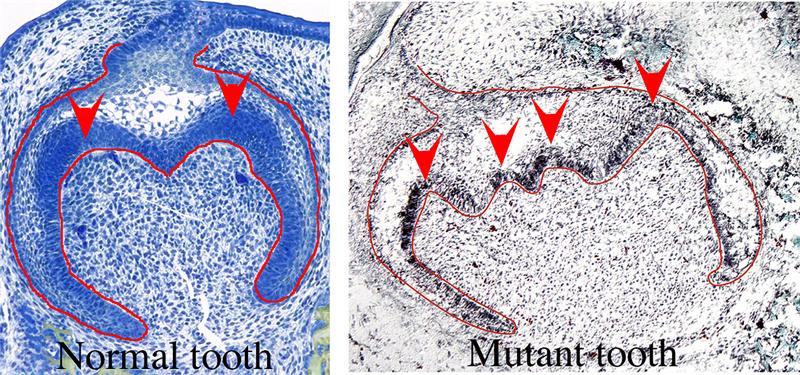Signaling pathways cells react to signals from their environment and one of the most important signaling pathways is the Notch signaling pathway. It is evolutionary conserved to a very high degree and it is involved in the development of all organs and tissues in animal and human embryos.
The Notch signaling pathway enables neighboring cells to adopt different fates. By this mechanism signals exchanged via Notch receptors between neighboring cells control formation, development and differentiation of organs. Similarly, formation and differentiation of teeth is controlled by Notch signaling.
The research team say they have now shown that in mice the Jagged2 gene is required for the healthy development of teeth. Inactivation of this gene interrupts the Notch signaling pathway resulting in serious tooth malformations - tooth crowns of the molars were deformed, additional cusps were formed. In incisors cell growth and enamel formation was blocked.

On the left, a healthy molar and the right deformed molar was with the Jagged2-gene deactivated in the mouse embryo. Credit: University of Zurich
Toward Bioteeth
Understanding the Notch signaling pathway and knowing the genes that direct form and shape of tissues is important for many areas of biology. Within the field of dentistry these findings make an important contribution to our knowledge, particularly for the field of stem cell research, says Mitsiadis.
The future goal would be to use stem cells not only for tooth repair, but also for generation of completely new teeth - bioteeth. That sort of advance requires knowledge of the precise genetic mechanisms that control tooth shape.
Generate a new tooth customized to a patient is not possible today but a combined solution is possible, says Mitsiadis. "A combination of stem cells with an artificial scaffold could constitute a solution for this problem."
Citation: Thimios A. Mitsiadis, Daniel Graf , Hansueli Luder, Thomas Gridley, Gilles Bluteau, 'BMPs and FGFs target Notch signalling via jagged 2 to regulate tooth morphogenesis and cytodifferentiation', Development, Vol. 137 / Issue 18, 2010, doi:10.1242/dev.049528






Comments